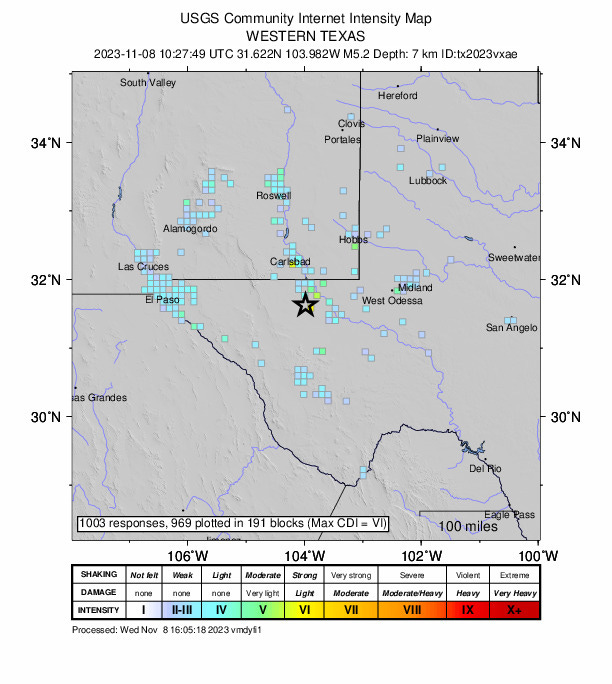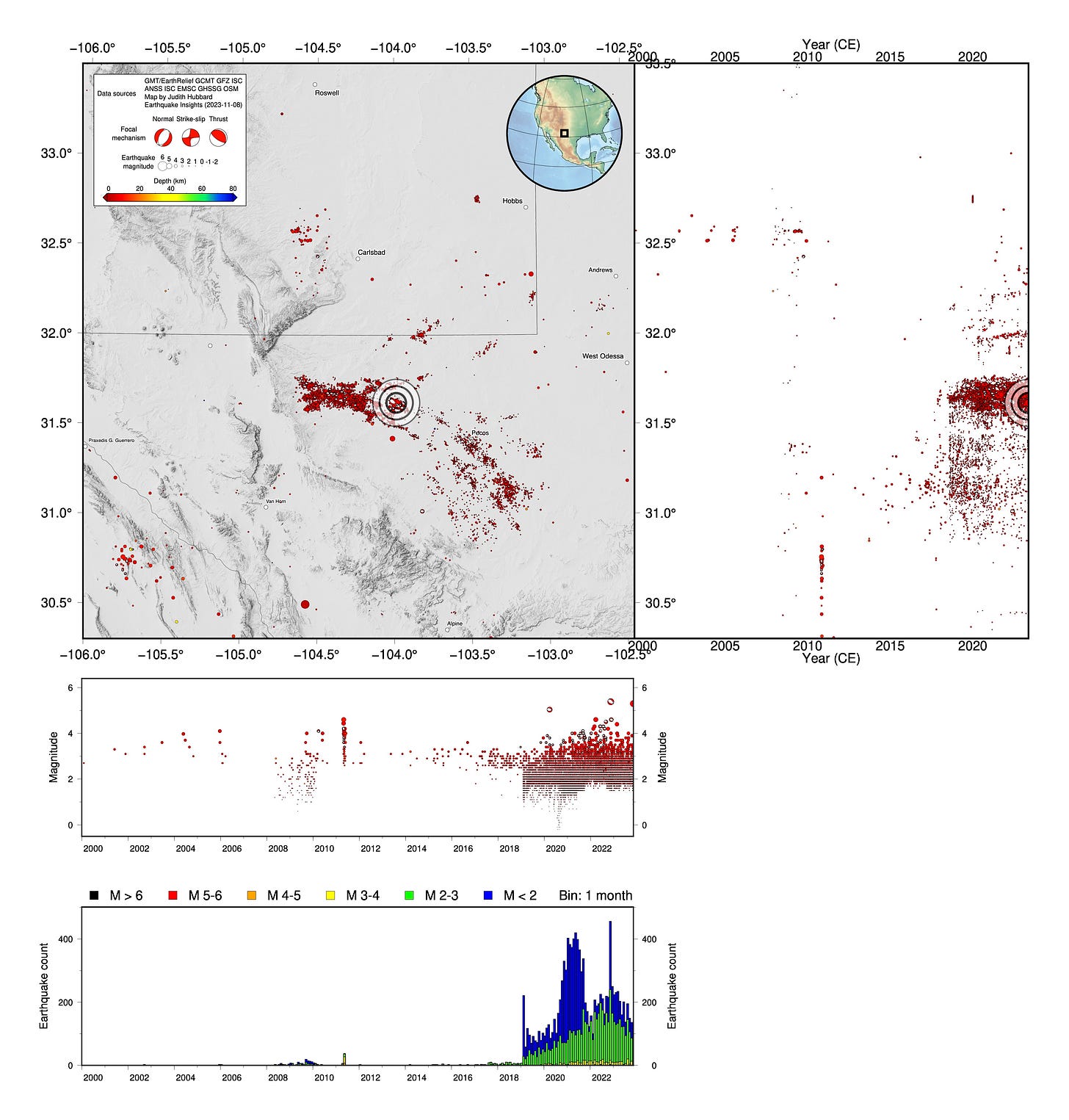M5.2 earthquake in west Texas likely anthropogenic
Similar to earthquake in November 2022 M5.4
Citation: Hubbard, J. and Bradley, K., 2023. M5.2 earthquake in west Texas likely anthropogenic. Earthquake Insights, https://doi.org/10.62481/e42ac8e9
Edit: M5.4, 2025-05-04
A M5.4 earthquake occurred on 20:47 local time on May 3, 2025 (May 4, UTC time). Testimonies to the EMSC can be found here. The local magnitude was ml5.4; the moment magnitude Mw5.1. The earthquake apparently caused quite very local shaking over a small area: one seismometer near the epicenter recorded peak ground acceleration above 1 g (intensity VII).
The earthquake occurred within a spray of seismicity that began in 2018, and since then has been pretty vigorous. This is the third earthquake of 2025 above M4.5, and the largest recorded so far in the western part of the seismic zone.
Like the rest of this earthquakes in the surging zone of seismicity, we can almost certainly ascribe this event to anthropogenic activity.

Original post, 2023-11-08
A magnitude 5.2 earthquake struck west Texas in the early morning hours of November 8, 2023. Weak to moderate shaking was reported by over 1,000 people, some more than 300 kilometers away, in both Texas and New Mexico. The earthquake occurred a little less than a year after a M5.4 earthquake in the same location that was felt over a wider area, reportedly damaging a historical building in distant San Antonio. The area is sparsely populated, so little damage is expected in this recent, smaller earthquake.

Earthquakes in west Texas
Moderate magnitude earthquakes can occur anywhere - including far from plate boundaries. However, a plot of seismicity of this region over time demonstrates that most recent earthquakes in west Texas are not natural. After years of little to no seismicity, the area experienced a surge of earthquakes starting in ~2018 that progressively increased in 2020 and 2021.
In the plot below, earthquakes are projected to the right onto a time series. Natural earthquakes look like vertical lines: mainshocks that trigger aftershocks, all around the same time. Sites of anthropogenic earthquakes, in contrast, look horizontal: repeated seismic events at the same location, spread out in time. While there are some apparently natural earthquakes in west Texas, the bulk of seismicity does not look natural.

Why are these earthquakes occurring? This is a region with significant fossil fuel extraction. The region is known as the “Permian Basin” - a thick stack of sediments below the Earth’s surface where buried organic materials, exposed to higher temperatures and pressures at depth, have transformed into oil and gas.

Indeed, a cursory glance in Google Earth illustrates that the epicenter is directly located near dozens or hundreds of sites used for fossil fuel extraction. Although it is usually difficult to tie a specific earthquake to a specific human activity, many of the earthquakes in this area have already been directly linked to the injection of wastewater into deep disposal wells and hydraulic fracturing. Fluid injection into the subsurface increases fluid pressures; these fluids essentially push the two sides of a fault apart, reducing the “clamping” stress that holds them together and allowing earthquakes to occur.


Because of this known connection, when the M5.4 earthquake struck in November of 2022, Texas responded by requiring that operators significantly scale back injection volumes. Indeed, it does look like seismicity rates started to decrease in late 2022, presumably a result of this restriction.
Notably, Reuters reported at the time: “If another magnitude 4.5 or higher quake occurs in that area, all deep wells within the boundary will shut for 24 months from the date of the event, regulators said. The area, called Northern Culberson-Reeves Seismic Response Area, is one of three areas with similar restrictions.”
According to the aftershock forecast from the USGS, the M5.4 earthquake had a 9% chance of causing an M5+ earthquake within the next year, so such an event was well within the range of possible. Notably, the recent M5.2 earthquake might have been triggered by the earlier M5.4 (i.e., it is an aftershock), rather than being directly linked to more recent wastewater injection. This kind of determination is difficult to make, requiring detailed study.
The issue of induced seismicity is not limited to Texas, or to fossil fuels. Any form of fluid injection into the subsurface can trigger earthquakes - including geothermal energy production and injection of carbon dioxide. While most induced earthquakes remain small to moderate in magnitude, larger earthquakes are also possible. In Switzerland, a geothermal project was abandoned in 2009 due to concern that fluid injection could trigger an earthquake on an underlying active fault. Careful monitoring of injection sites and triggered earthquakes is necessary to better understand causes and effects.
References:
Savvaidis, A., Lomax, A. and Breton, C., 2020. Induced seismicity in the Delaware Basin, West Texas, is caused by hydraulic fracturing and wastewater disposal. Bulletin of the Seismological Society of America, 110(5), pp.2225-2241. https://doi.org/10.1785/0120200087
Skoumal, R.J. and Trugman, D.T., 2021. The proliferation of induced seismicity in the Permian Basin, Texas. Journal of Geophysical Research: Solid Earth, 126(6), p.e2021JB021921. https://doi.org/10.1029/2021JB021921
Some additional reading:
Dvory, N.Z. and Zoback, M.D., 2021. Prior oil and gas production can limit the occurrence of injection-induced seismicity: A case study in the Delaware Basin of western Texas and southeastern New Mexico, USA. Geology, 49(10), pp.1198-1203. https://doi.org/10.1130/G49015.1
Hicks, S.P., Goes, S., Whittaker, A.C. and Stafford, P.J., 2021. Multivariate statistical appraisal of regional susceptibility to induced seismicity: application to the Permian Basin, SW United States. Journal of Geophysical Research: Solid Earth, 126(12), p.e2021JB022768. https://doi.org/10.1029/2021JB022768
Scanlon, B.R., Weingarten, M.B., Murray, K.E. and Reedy, R.C., 2019. Managing basin‐scale fluid budgets to reduce injection‐induced seismicity from the recent US shale oil revolution. Seismological Research Letters, 90(1), pp.171-182. https://doi.org/10.1785/0220180223
Schultz, R., Skoumal, R.J., Brudzinski, M.R., Eaton, D., Baptie, B. and Ellsworth, W., 2020. Hydraulic fracturing‐induced seismicity. Reviews of Geophysics, 58(3), p.e2019RG000695. https://doi.org/10.1029/2019RG000695
Zhai, G., Shirzaei, M. and Manga, M., 2021. Widespread deep seismicity in the Delaware Basin, Texas, is mainly driven by shallow wastewater injection. Proceedings of the National Academy of Sciences, 118(20), p.e2102338118. https://doi.org/10.1073/pnas.2102338118






Any statistics to distinguish whether this earthquake was just a normal aftershock, in line with Omori's law, or an independent one triggered by the ongoing injection, as the last one probably was? I'd guess the latter, which would mean it is not an aftershock.
Minor edit needed: date listed in first paragraph is “Nov 18” which would make this the first predicted future earthquake ever!! 🥹